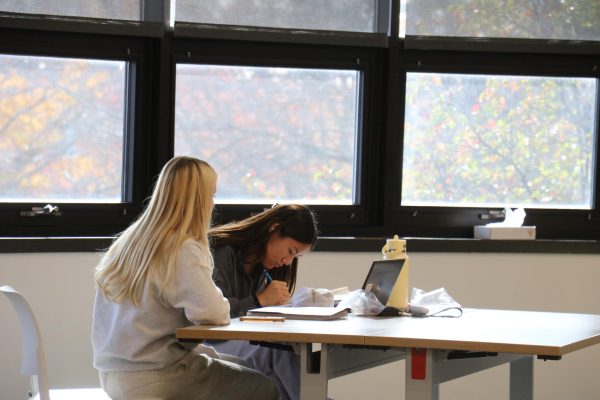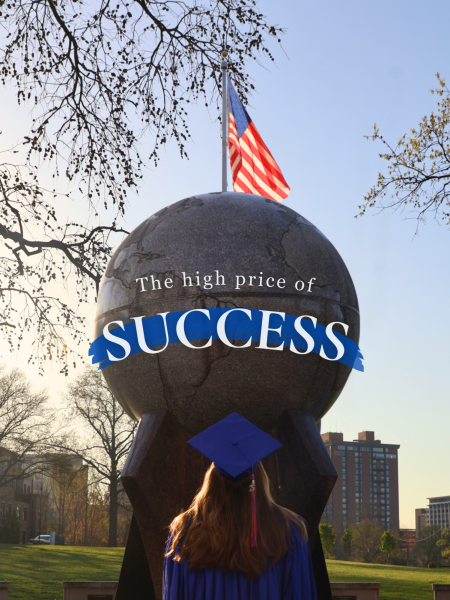63105: The Gilded Zip Code
Living in 63105, the zip code corresponding to the city of Clayton, brings many financial benefits purely from being in an area of accumulated wealth.
63105: The Gilded Zip Code
Every August, a new class of Sperry-stepping, Patagonia-sporting students strut through the doors of CHS into what will be one of their many experiences with the “Gilded Zip Code.”
These students, the majority of whom are the offspring of mid- and upper-level professionals are fortunate enough to be born into the gilded zip code — an area of good neighborhoods, families and economic status. Residents of the gilded zip code believe in hard work and merit, but as their consolidation of wealth grows, so do their disproportionate advantages.
Enriched through tax breaks, investment in the stock market and rising property values, the class belonging to the gilded zip code continues to consolidate wealth. While recent administrations have issued tax breaks for the rich to continue this consolidation, the idea isn’t new.
“We’ve seen rising concentration of wealth not just within the top quintile of Americans in terms of wealth and income, but also more specifically within the top 10 percent and then within the top one percent … that idea of greater concentration of wealth and income isn’t new. It’s dated back to really the early 1980s, late 1970s,” Daniel Glossenger, CHS AP Economics teacher, said.
However, for most Americans, this consolidation resides in home-ownership.
“The vast majority of wealth in this country, in terms of the middle class, is in home equity. Access to homeownership was and remains both the Republican and the Democratic party goal. So both George W. Bush and Bill Clinton pushed getting access to home loans for people with lower incomes and Barack Obama did as well,” Glossenger said.
A seemingly bi-partisan goal breaks off at the upper 10 percent of Americans. For this crowd, 9.9 percent of whom belong to the gilded zip code, the world of bonds and global financial markets enters the picture.
“High-income earners are able to take gains in income and put those gains into financial markets. And I say that broadly to say a trust fund wouldn’t be just money sitting in an account, right? It’s invested in bonds, it’s invested in real estate investment trusts or [real estate investment trusts] where it’s invested in the stock market,” Glossenger said.
The reason for this is evident in the income growth of the upper quintile of Americans.
Richard Reeves, a scholar at the Brookings Institution and author of “Dream Hoarders: How the American Upper Middle Class Is Leaving Everyone Else in the Dust, Why That Is a Problem, and What to Do About It,” points to a Congressional Budget Office study spanning over 34 years between 1979 and 2013 in which Americans in the top 20 percent saw a 4 trillion dollar income increase compared to the bottom four-fifths, who had a mere 3 trillion dollar increase total. This increase opens up many more opportunities for consolidation of wealth to the top quintile.
Trust funds or accounts with growth opportunity are set up to exceed inflation. These accounts can often outlast one’s life or be opened for young children to access later in life. While the name “trust fund” might sound daunting, the reality is that many Americans who have good access to job opportunities are able to consolidate their wealth in a growing account. As for the bottom earners, they can, in part, attribute their growth, or lack thereof, to wage stagnation.
“The labor market is really where income concentration on very high-income folks is happening, and wage stagnation is happening for a large number of Americans,” Glossenger said. “[Building generational wealth] is fairly straightforward for people who are earning a relatively high income. It’s relatively challenging for people whose wages have stagnated.”
For those not facing the same issues as the lower and middle class, the passing of consolidated wealth is much easier. By dumping money into great neighborhoods with good school districts, they directly impact the futures of not only their own children but also those of the children of their gilded zip code neighbors.
“Clayton has always outspent other school districts. We could go back to the 1950s and 1930s and look at per-pupil spending—this district has spent more than every other district for decades, if not a century,” Glossenger said.
The District’s spending, combined with the other various factors of the gilded zip code, provides Clayton students an innate advantage.
Bright-eyed CHS students enter the high school ready to toil away at hours of honors freshman physics homework to get ahead in this seemingly meritocratic system. But they wouldn’t have gotten a spot in this system if it weren’t for their family’s consolidated wealth and reaping of the benefits in the gilded zip code.
“We say it’s a merit-based system. I didn’t get my job here entirely on merit. I knew people here and my original internship placement here was because the person running the internships knew the school and they had a long-standing relationship. So I think we lie to ourselves if we say everything’s based on merit,” Glossenger said.
In a society that often attributes its successes to merit, it is important to consider other factors of wealth that are at play. Proponents of wealth are at the center of a web that stretches towards experiences of education, health, jobs, neighborhoods and family.
Education
Five digits of separation.
This is the phrase that former California Senator Gloria Romero coined to describe the devastating influence of zip code on a child’s quality of education. Five digits that could mean the difference between a safe household and an unstable one, a high school or college degree, a blue collar or white collar job — five digits that ultimately have a substantial impact on the future of a child. Just one misplaced integer can alter the course of a life.
In 2013, The Washington Post created a tangible map of every zip code in the US. Each zip code was then evaluated, on a scale of zero to 100, on the combined quality of education and income of its inhabitants. Clayton, with a code of 63105, scored a 95 on the scale, qualifying it as one of only 650 total “Super Zips” (zip codes in the top five percent) in the nation. 63106, a north St. Louis neighborhood only one digit away from Clayton, scored a one.
According to the United States Census, those living in 63106 are primarily African-American with a median household income of $15,031 and 11 percent have a bachelor’s degree or higher. Conversely, 96.8 percent of residents of zip code 63105 has a college education.
These are not just statistics, they are predictions.
Multiple studies have consistently found that the level of education of a parent is directly correlated to the education level of their children. For anyone born in an area of low socioeconomic status, obtaining a higher level of education proves to be especially difficult and rare.
In 2007, two predominantly African American city school districts–Riverview Gardens School District and St. Louis Public Schools–lost accreditation. Shortly afterward, in 2012, Normandy School District lost its accreditation as well. Though all three schools made improvements and reopened in the following years, the state of education in the city continues to remain turbulent. This means a lack of security for the many low-income children going to those schools, a large portion of whom had to be bused away from their own neighborhoods when their districts shut down.
The Hawthorn Leadership School for Girls, located in a zip code which was given a score of eight by The Washington Post, is working to overcome these issues and to provide a safe environment and high-quality learning program for its students.
“One of the things the founder, Mary Stillman, and the other founding board members focused on was making Hawthorn a joyous place. We wanted the girls to really feel safe, and feel appreciated, and to have a good time while they are working hard, and I think that’s the way it feels,” Edes Gilbert, board member and co-founder of Hawthorn said.
Hawthorn, founded in 2014, is an all-girls charter school located in the 63113 zip code. As such, it is non-selective and receives state funding to provide meal support and academics for girls grades six through 12. Because it is essentially a public school run like a private school, it operates on a first-come-first-serve basis. Hawthorn is steadily growing but has not yet reached capacity.
“Any new enterprise takes a while to get started. Part of it is because it’s all girls. Because we’re new, we don’t have a lot of ‘fun things’ about high school that you do. It’s coming, but it’s been slow,” Gilbert said.
Although it may be developing slowly, Hawthorn has come a long way from its founding, with programs such as volleyball, dance and track receiving serious enthusiasm from participants. Shared resources with local facilities and money coming in from the city via a foundation that runs parallel to the school are also to thank for these advancements, as well as teacher compensation.
“St. Louis has been very supportive. We raise somewhere around a million dollars a year. So that fills in the blanks, and allows us to pay the teachers a little bit more,” Gilbert said.
Generous donations to the school allow it to provide for the majority of its students who live in impoverished homes.
“There’s quite a variety [of family situations]. Low income would be a common denominator. Over 83 percent are on paid lunch. We serve breakfast as well because you can’t learn if you’re really hungry and if you haven’t had dinner the night before. We serve breakfast and lunch for everybody. The state pays a certain amount for every child, and we add to that to cover the rest.”
Gilbert stressed that even with substantial funds, the success of the school and its students depends largely on the parents’ determination to build a successful future for their children.
“Parents are basically working two jobs. But they’re on the low end of the salary scale. I would say that 98 percent of the parents are focused on allowing the girls to have opportunities that they did not have. You can see the American Dream. You are going to get an education. Parents are by and large amazing. Even if they haven’t had a lot of schooling themselves, they are really focused on supporting the school, and we try to support them, so we spend a fair amount of time with parents.”
Although St. Louis has and will continue to have wealth disparities, often related to location, Gilbert believes that educating St. Louis’ youth in a way that leaves little out-of-pocket costs for families is one step towards ensuring successful futures for children regardless of their socioeconomic status and a subsequent narrowing of this gap.
“This wasn’t about white people sailing in from Clayton with their checkbooks. These are people who really believe in education, and are ready to roll up their sleeves and work for it.”
“I got involved because it really seemed to me that St. Louis was having a hard time as a city when I was here in the 80s. St. Louis is still having a hard time, but the lack of hope and opportunity for young people just seemed to me devastating, just the little that I had seen of it. And I’d like to think that we can offer our girls hope.”
Brian Walsh, member of a Clayton law practice and Clayton parent, echoed Gilbert regarding the influence education can have on the rest of one’s life for low and even middle-class families. Growing up as one of six siblings and attending school in a rural location of Long Island, Walsh stated that he owes a large part of his and his children’s success to his education.
“My education instilled in me the fact that it is so important, even if you decide to do nothing with it, it just rounds you out. It gives you a base, so you can educate your own children.”
Although Walsh eventually made the jump to law school at George Washington University in a much more urban setting after completing his undergrad, he said that even the vast difference in setting was not the most shocking transition for him. The few resources of his high school setting instead made the transition from high school to college more drastic.
“It’s interesting, because I’m watching you guys get prepared for college and everything else, and that whole piece was missing in my high school. So the bigger leap for me was high school to college,” Walsh said.
The substantial resources available to Clayton to make the high school to college transition fluid not only ensure that most students will go on to a four-year university, but also ensure student success in this setting, and eventually pave the way for an independent life.
“When I first moved here well over 20 years ago, we lived in Kirkwood, and it was not quite as affluent as Clayton was, so I think there were several routes that kids could take other than the traditional college, or gap year and then college. I got nothing but ridicule from my siblings for leaving and going to college. But I think, in Clayton especially, the expectation is you’re going to go to a good school, and you’re going to get a good education, and you’re going to leave home,” Walsh said.
According to CHS Counseling Department Chair Carolyn Blair, approximately 98 to 100 percent of Clayton students go on to pursue a college education on any given year.
“Our percentage rate is pretty high, compared to neighboring [public] and private schools. We are probably more similar to private schools than we are to [other public schools],” Blair said.
Although similar to others in the St. Louis area, the matriculation of Clayton students differs from private schools in one major way: location.
“When you look at where our students go, that’s probably the largest difference with us. At schools like Pattonville or Lindbergh, over half of their class goes to community college and the rest go to Mizzou or very close-by state colleges. My first 10 years here, I’d say about 70 percent of our class matriculated out-of-state than in-state,” Blair said.
Although Clayton’s high rate of matriculation is often a source of pride for its patrons, the relative wealth and resources of Clayton may contribute to the pressure placed on students to immediately receive a traditional secondary education, students for whom this may not be the best option.
“We have students that decide to do something else. Frankly, we have students who would prefer to do something else, but because they go here, they feel pressured to [go to college] because they feel like they have to because that’s what you do.”
Though zip code and socioeconomic status contribute largely to one’s ability to pursue education, it is important to remember that college is not the right path for all. In a place like Clayton, college is often regarded as a necessity rather than one option among many. Education is a vast field of resources, which, when explored, can supplement one’s future regardless of wealth.
Jobs
“[A strong socioeconomic background] helped me land a really good college,” Jennifer McKeown, CHS graduate and current resident of University City, said.
McKeown, like many others, believes that the upper class is often drawn to Clayton in search of a good education for their children. Those who fall below the high economic standards of Clayton, as a result of expensive real estate and competitive businesses, are often prevented from existing inside the exclusive “Clayton bubble.”
“I’d love to live in Clayton. I don’t know if we can afford that right now,” McKeown said.
The high academic standards of Clayton are appealing to McKeown, as she experienced the school district’s rigor firsthand in the Class of ’03 before attending Tufts University. She is currently a Youth in Need counselor at Craig Elementary in the Parkway School District, and she believes the education she received at CHS helped solidify her current success. Her education at Clayton and the opportunities and resources it provided her with, she said, still play a tremendous role in her life.
“I think the connections I made at Clayton carry on since I’ve been back here and help professionally and help my family,” McKeown said. “They have helped build some good professional opportunities.”
According to Glossenger, the connections in the field play a very important role in the job search. Often times, the highest paying jobs require these connections, and without a connection in a high-paying field, job explorers are often left in the dust.
Without these personal connections to guide him, Glossenger perhaps would not have ended up with a job at CHS. In fact, the idea that the obtaining of jobs is entirely based on merit is a common belief, and according to Glossenger, a common misconception. In reality, there are many other factors of networking at play. Equally if not more important to the securing of a job as networking is the pursuit of internships, and the two often coincide.
Author Matthew Stewart who wrote the Atlantic’s June 2018 cover story entitled, “The Birth of the New American Aristocracy,” echoed a similar idea. “Over half of Ivy League graduates typically go straight into one of four career tracks that are generally reserved for the well educated: finance, management consulting, medicine or law. To keep it simple, let’s just say that there are two types of occupations in the world: those whose members have collective influence in setting their own pay, and those whose members must face the music on their own,” Stewart writes.
Generally, those able to attend college are members of the first group. CHS has a graduation rate of 98 percent, significantly higher than the national average of 90 percent of people 25 and older, according to the U.S. Census. CHS graduates will have more opportunities to succeed in higher paying jobs, and to have control over their pay, than most high school graduates.
According to Glossenger, high school has a large impact on a student’s future, not just their college career. Moving between quintiles is possible, but is made much easier through a proper education.
“When you’re just out of college, you might be in a relatively low-income quintile, and you may have zero income for a year, who knows, but over the course of your lifetime, you might get really, really high levels of income,” Glossenger said.
Though rising from a state of poverty to one of wealth is admittedly extremely difficult, higher education has been directly correlated with the ability to change one’s socioeconomic status.
“It’s access to education–college education or higher education in general–and access to vocational training. It’s access to good-paying jobs,” Glossenger said. “In this country, good paying jobs are accessible primarily through a vocational training–essentially post high school technical education–or through advanced degrees, four-year and higher.”
There is no doubt that Clayton students are privileged in their access to academic resources, which is reflected in the fact that the majority of its graduates attend four-year colleges. However, it is important to recognize that only 46 percent of students across the U.S. attend a four-year university.
I think we live in a bubble in Clayton, where we think the vast majority of high school students go to a four-year college. The vast majority of young people, even today, do not finish a four-year degree. It’s not what’s done and it’s not through a choice as much when we say an individual’s choice. I think a lot of it is a structural outcome. There are lots of things about access to higher education that are problematic.
One chronic problem is the increasing average college tuition. It is currently rising at a rate that is greater than the rate of inflation, thus pushing the less wealthy away from this essential opportunity for securing a high paying job. Although factors such as networking, merit and location all influence into one’s ability to obtain a high-paying job, socioeconomic status greatly determines what opportunities are available to individuals and can determine their future. The disparity of wealth in our country inevitably leads to a disparity in jobs, which leaves populations at the lower end looking towards a dim future.
“[The most affluent people] are hoarding the American dream,” Glossenger said.
Neighborhood
18 years.
Based solely on geographic location, a child born in Clayton, zip code 63105, is expected to live 18 years longer than a child born in the JeffVanderLou area, zip code 63106.
A difference of just one zip code digit can significantly alter the course of a life. One’s predicted opportunities and outcome are determined by the neighborhood in which one grows up. The resources a community provides are essential in early childhood development and later life; the school district, access to jobs, healthcare and housing all play a role.
Those fortunate enough to enter the world in a richer family in a wealthier area will have innate advantages throughout their life, subject to the generational wealth and connections accumulated by their parents before their birth. However, those born in poorer neighborhoods will have to exhibit a greater effort to reach the same level of success as their wealthier counterparts.
“The idea that our whole society is built on merit is an illusion,” Glossenger said. “We have a meritocratic system up to a point, but it’s access to the things that give you merit, that is really, really difficult to obtain. I think it’s easy for people who live in systems and within structures that merit comes naturally to say, ‘well, of course it was through my own hard work.’”
To many lower-income Americans, purchasing property is central to achieving the American Dream: a chance to acquire wealth and pass it on to future generations. However, given the current housing market, simply owning a home is no longer enough to ensure economic prosperity. Houses in wealthier areas are much more likely to significantly appreciate in value than those in poorer areas.
“It’s easier to maintain property values when you have a large number of high income and high wealth individuals in a certain area,” Glossenger said. “And property values are usually tied to school districts as well.”
The current divided state of St. Louis is a result of decades of white flight. Beginning in the 1950s and 60s, St. Louis experienced a large movement of white families out of the city and into surrounding suburbs.
“Some of it was racism, some of it was classicism, wanting to live in an area with people who looked like you, made the same amount of money as you,” Michelle Witthaus, a program director for Washington University’s Health Equity Works program out of the Brown School, said.
According to Glossenger, racial housing segregation was often perpetuated by ostensibly race-neutral restrictive zoning policies. By prohibiting construction of more affordable housing options, such as apartment buildings or town-homes, in favor of bigger properties with large lawns, the government indirectly shaped the demographics of the area by determining the economic statuses of the people who live there.
However, in 1916, the City of St. Louis implemented a purely racial zoning ordinance. This ordinance, the first of its kind in the nation, stated that people of a certain race could not purchase a home in a neighborhood where more 75 percent of the inhabitants were of a different race. Although the Buchanan v. Warley U.S. Supreme Court case reversed and outlawed this referendum the following year, it set a precedent for the development of other racist housing policies and started a trend of white flight towards exclusive suburbs surrounding the city.
On a local level, racial deed covenants provided neighborhoods with a way to control their demographics and prohibit individuals of certain races from purchasing property. After a 1926 U.S. Supreme Court case, Corrigan v. Buckley, ruled that these covenants were not subject to the 14th amendment, which grants equal rights and legal protection to citizens, they quickly gained in popularity. Often, these restrictions comprised clauses on home mortgages that stated landlords could not sell a property to non-white families.
“They were on houses for sometimes up to 50 years,” Witthaus said. “With that, we really started to see this immense segregation in St. Louis. People would put these covenants on their properties and an entire neighborhood would remain white, really limiting options for African Americans to purchase homes.”
With the implementation of the Fair Housing Act in 1968, Congress outlawed housing discrimination based on race, religion, sex or nationality, and thus racial deed covenants. Usage of covenants had been in decline since 1948 when the Shelley v. Kraemer U.S. Supreme Court case ruled that they could not be supported judicially. However, housing discrimination continued.
“Even though racial deed covenants were no longer legal, we found new ways to segregate communities,” Witthaus said. “Real estate agents continued to steer white clients to certain subdivisions and black clients to certain subdivisions. We’ve continued to find innovative ways to segregate people that aren’t technically illegal.”
The effects of this segregation have endured. According to Witthaus, today St. Louis ranks among the top 10 most segregated metropolitan areas in the nation.
In neighborhoods with high poverty rates, social mobility is severely limited by the availability of services and amenities that promote healthy lifestyles. In communities similar to Clayton, infrastructure such as paved sidewalks and well-maintained parks allow residents to exercise outside, and close proximity to grocery stores allows access to fresh produce, contributing to healthier diets. Poorer neighborhoods are also more likely to have greater crime rates and exposure to pollution, according to a 2015 report from the For the Sake of All initiative.
“There are many health disparities in St. Louis, but we can measure them by the amount of time one is expected to live. And here it is directly related to your zip code and what you have access to where you live.”
Family
63105 attracts a certain kind of family.
Homes are expensive, streets are safe and public schools are more than adequate. According to the 2017 United States Census, 16,805 people inhabited Clayton. 14.8 percent of households contained children under the age of 18. 77.6 percent of the population was white. The median income per household was $91,531. As of 2017, that amount is $38,664 for St. Louis. Nationally, it is $61,372.
So what is so special about Clayton families? And how are these families able to accumulate wealth?
“Almost all of your classmates are going to go to college, and that’s a lot of money,” Washington University economics professor Robert Pollak said. “That’s going to play a big role in determining their lifetime income.”
Much is still unknown about how significant the wealth of one’s family is to their own wealth and in the future. The concept of wealth is turbid, with economists frequently questioning the effect of one’s income on their accumulation of wealth.
Inheritance also plays a large role in how wealth is passed down from one generation to the next, yet, as lifespans increase, this process is happening later and later in life. “Think about your classmates and the parents of your classmates,” said Pollak.
“Think about the grandparents’ generation. Remember that the parents are not actually going to inherit yet. Your parents’ generation will not inherit until both the grandmother and grandfather died. They won’t inherit until the surviving spouse dies. That’s a long time off in general, but particularly for the people we’re talking about.”
This resting period causes a delayed surge of wealth due to the passing on of family members. The sum of inheritance money may be great, but it is difficult to predict this amount as it has not yet been passed on. As a result, economists have begun to measure upper-middle-class success in terms of human capital instead.
“There’s a tremendous amount of money that’s going to be inherited by your parents’ generation, but they’re going to be pretty old. So for most people, I would think about it in terms of human capital and investment in education,” Pollak said.
However, the money and resources donated to a child living in Clayton do not just merely include a college education.
“Consider the School District of Clayton,” Pollak said. “We can think of the public schools as being, in a sense, free. They are paid for with taxes. That’s one of the reasons why homes in Clayton are really expensive. It’s because they’re in a good school district. And because taxes are high. So it’s not just that the parents are spending a lot on college, they’re also spending a lot on housing. And that makes a lot of difference over years and years. College is, after all, only four years.”
Pollak also touched on more non-traditional families and how their lifestyle affects their wealth and stature. A large portion of the families in Clayton have two parents in their household, so these statistics don’t often apply to Clayton families.
“I think most of your classmates are going to come from nuclear families. Their mom and dad are both going to be there,” said Pollak. “Most of the parents are going to be college graduates, and they’re going to have high incomes. And what we don’t really understand is the relative importance of those factors. And there’s no easy way to find out because you can’t do experiments. Those three factors tend to go together.”
In the 2017 Census, it was recorded that Clayton features a 42 percent marriage rate, 48 percent of residents have never been married, and six percent of residents are divorced. Additionally, only five percent had a female householder with no husband present and only two percent had only a male householder with no wife present.
“In the jargon of demography, this would be called non-marital, for there are women who are having children when they’re not married before their marriage,” said Pollak. “That is relatively uncommon among college graduates, but not unheard of. But the probability that a woman who’s a college graduate will have a child without getting married is 20 percentage points lower than a woman who is not college a graduate. Just very large differences.”
This pattern is not common in Clayton, due to a majority of parents being college graduates. The nuclear family settings are just one of the many aspects that allow for Clayton families to find themselves in the upper 9.9 percent.
“So you have these big differences in family structure. The women who are college graduates are likely to marry before they get pregnant. And they’re likely to stay married. Which is interesting, because there’s a sense in which that means the women who are best able to raise children on their own are getting married and staying married,” said Pollak.
Many who have lived in Clayton for elongated periods of time find themselves in a “Clayton bubble.”
Having grown up in a rural community of Long Island before moving to St. Louis and sending his kids to Clayton schools, parent Brian Walsh has a unique outsider perspective on the “Clayton bubble” and how academics operate within it.
Walsh was the only one of six siblings to attend college. Parental interaction and money were treated very differently within his family than they are at Clayton.
“It’s funny to go to all the parent interaction events and everything else because that just didn’t happen [where I grew up],” Walsh said. “But I mean, my graduating class had 732 kids. So the level of parental involvement in that day and age was less than the expectation is now. But I think it’s great. I enjoy it; I want to be part of it. I want to know what’s going on.” Walsh had to save money and pay his own way through college, and then law school. Now, with his daughters who have gone through and are going through the Clayton school system, Walsh has noticed many palpable differences between resources available to him and resources that are currently available to his daughters.
Additionally, not growing up in Clayton allows for Walsh to view Clayton’s community and families with a different perspective.
“I did not grow up here, so I sort of look at [Clayton] slightly differently,” said Walsh. “But I think there is a little bit of this Clayton bubble mentality here. There’s this parochial view of what’s right and wrong. And I would say 90 percent of the time I agree with it. But sometimes I think it does look too much at itself. One would like to think that Clayton is reflective of everybody else, but I don’t know that we are.”
Walsh views families in Clayton as very different from other St. Louis families. Having worked as a lawyer in different locations across St. Louis and having lived in Webster, he has seen the differences that these communities have with Clayton firsthand.
“There is this idea that we are the best of the best, and on occasion, there is a little bit of looking down the nose at certain other neighborhoods. But I also think that there’s almost an ingrown sense of being more willing to go to other places. We know that Clayton doesn’t have everything, so we frequent the Central West End and we’re not afraid to go downtown to the theater or the ball game. I can tell you from working in West County that it’s a whole other world. You step outside [highway] 270 and it’s its own entity.”
Another member of the Clayton community is Jennifer McKeown, CHS alum, Clayton tennis coach and daughter of longtime Clayton resident Susie Luten. She and both of her siblings attended CHS. Although McKeown now lives in University City, she has very fond memories of growing up in Clayton with her family.
“It was very comfortable,” said McKeown. “It was easy and I loved having my friends very close that I could hang out with and walk to. The friends that I made in elementary school and in high school are still some of my friends today. It’s definitely very sheltered, which I can see now after growing up, and definitely its own little bubble.”
McKeown believes that people are pulled to Clayton because of its top-ranked public school system, as well as the tolerant mindset that Claytonians take up.
“Some of the families that are drawn here are — I don’t want to say middle but upper class — and want a good education. And they also want, I wouldn’t call it diversity, but I would call it more open-mindedness for and respect for lots of different lifestyles,” said McKeown.
While McKeown enjoyed being raised in the Clayton community, she now realizes that the wealthy suburb lacks some much needed racial diversity.
“Living in U-City now, versus being raised in Clayton, I think in U-City there’s definitely more diversity and openness for not being as showy with your wealth. I feel like there are more different cultures that you can learn from, and festivals and things. Clayton doesn’t necessarily have those opportunities because they don’t have the people in the population to grow those,” said McKeown.
McKeown’s mother, Susie Luten, met her husband Sam Luten when they were attending sixth-grade camp in the year 1969. Both of McKeown’s parents graduated from CHS, as well as Susie’s mother and Sam’s father. This third generation Clayton family is deeply rooted in the community.
“It seemed like it was just the perfect place to grow up. The school was wonderful and we had great friends. I went to Meramec, which I could walk to from my house. I went to Wydown and went to sixth-grade camp. I then went to the high school, which was a fabulous high school. Everyone there was going to college. It was a small high school where everyone knew each other. It was a great way to grow up,” said Luten.
After Susie and Sam were married, the two moved back to St. Louis but took up residence in Brentwood. They found the community to be similar to that of Clayton, moving back to the suburb from which they came for merely school district related reasons.
“I wouldn’t say they were different in any way, shape, or form. We still are friends with many of those families. The older kids in the neighborhood babysat for us and the adults were some of our friends. It was very similar. They only reason why we moved from that neighborhood was because most of those parents were sending those kids to parochial school,” said Luten.
Many of the Luten’s peers also decided to build their families where they were raised: within 63105.
“When I look at my particular graduating class, my husband’s graduating class, class of 76, how many of our really close friends how many of our really close friends moved back to Clayton,” said Luten. “That is pretty unique, as far as I’m concerned.”
Health
St. Louis’ “For the Sake of All” report–a project undertaken by Washington University in St. Louis to address health equity throughout our region – states, “While personal responsibility for making healthy lifestyle choices is important, the context in which choices are made matters a great deal.”
In 63105, personal responsibility is the overarching factor impacting a healthy life. In 63106, a healthy life is a luxury that personal responsibility can barely begin to touch.
While wealthier zip codes attract wealthier individuals, the congregation of wealthier individuals attracts health resources.
In neighborhoods like Clayton, residents have easy access to a myriad of grocery stores and supermarkets where they can purchase healthy foods without difficulty. There are safe parks where people can play and exercise, and gyms where people can get their daily workout. Within allotted hours, students at CHS are even allowed to use the Center of Clayton recreation center for free. People in Clayton are also never too far from a hospital or an urgent care clinic.
Residents of lower socioeconomic regions have virtually none of these resources.
“[A healthy lifestyle] definitely is impacted by the socioeconomic status of the population in those zip codes,” said Robert Poirier, emergency physician and clinical chief of emergency department at Barnes Jewish Hospital.
Grocery stores, similarly to any other businesses, locate themselves in both areas of higher population and areas where people can afford to pay for their goods.
Neighborhoods like Clayton make great candidates for markets to set up shop, creating convenience for residents and for store owners.
However, when stores and supermarkets congregate in wealthier neighborhoods, people in less wealthy areas are left with virtually nowhere to access healthy, substantial food, creating the effect known as “food desertification.”
These areas breed obesity and other ailments simply because the people living there, given no healthy options, must default to unhealthy choices.
Food deserts leave people with two basic options: buy what food is provided, or travel long distances to just to have access to something better.
Frequently, even if a person is willing to go further for healthier food options, they can’t afford enough of the quality food to feed themselves and their family. This leaves people to buy cheaper foods, which are typically processed and less nutritious.
“It’s tough,” Poirier said. “If you don’t have a car and the supermarket’s ten miles away, how do you get there? And often times you can only buy what you can carry.”
The distribution of urgent care centers and health clinics follows a similar pattern to that of grocery stores. Wealthier areas mean that more people in the area have health insurance, and can, therefore, afford care.
With medical care so far away from less wealthy neighborhoods, people have to not only traverse long distances to get access but also pay for it, often out-of-pocket. As a result of not having health insurance, people may ignore easily-treatable issues until their conditions become unbearable, or even neglect to seek medical treatment at all.
While people who can access regular, affordable healthcare understand how to navigate the healthcare system, people of lower socioeconomic status also have lower healthcare literacy, and therefore cannot adequately treat their medical issues.
Distrust in the system also contributes to poor health. For example, having paid for a treatment that failed, people of lower socioeconomic status will frequently ignore follow-up care or decline to make a second doctor’s appointment.
This results from the failed treatment creating a lack of trust in the health care system. After all, they just paid money for a treatment that did nothing to improve their condition.
Because they have less healthcare literacy, they may not understand that there are alternative treatments for most issues.
They may also understand that other treatments can be used, but again, cannot afford to pay for them.
While wealthier individuals might drink or smoke for recreation, wealthy people are less prone to use substances to medicate a condition known as “toxic stress.”
Use of these substances in areas of poverty result from situations such as possible neighborhood violence or having to work multiple jobs to make ends meet. As a result, many people try to self-medicate this induced stress through drugs, alcohol and smoking. This can lead to chronic diseases, such as addiction, lung cancer or cirrhosis. Again, these conditions will likely not be treated.
To quote the For Sake of All Project, “health is about more than what happens in a doctor’s office or a hospital room. Health allows us to engage fully in the activities of our daily lives and to make meaningful contributions to our communities. It is fundamental to human well-being, but it is not equally distributed across our community.”
A $50 or more donation includes a subscription to the Clayton High School Globe 2024-2025 print news magazine.
We will mail a copy of our issues to the recipients of your choice.
Your donation helps preserve the tangible experience of print journalism, ensuring that student voices reach our community and that student democracy thrives.

Michael Bernard is a senior at CHS. This is Bernard’s fourth year on the Globe staff. He is currently serving as the Editor-in-Chief, and in the past has served as Senior Managing...

Jacob is a senior at CHS and this is his fourth year on the Globe. He is currently serving as the Editor-in-Chief, and in the past has served as Senior Managing Editor and News...

Michael Melinger is a Senior at Clayton High School. This is his fourth year on the Globe. He currently serves as the Chief Multimedia Editor for the Globe. This is his third...
Grace Snelling is a senior and is Editor-In-Chief of the Globe this year. She has previously been a reporter, page editor, and senior managing editor. Throughout her childhood,...

Sara Stemmler is a CHS senior completing her fourth year on the Globe staff. Apart from writing for the Globe, Sara competes in tennis and track. She also tutors elementary students...
Anna Sturmoski is a junior at Clayton High School, and this is her second year working for the Globe. After her first year as a reporter on the staff, she will be taking on the...

Lila is a junior and this is her third year as a member the Globe staff. She is a senior managing editor and is very excited for the year ahead. She was a feature section editor...







